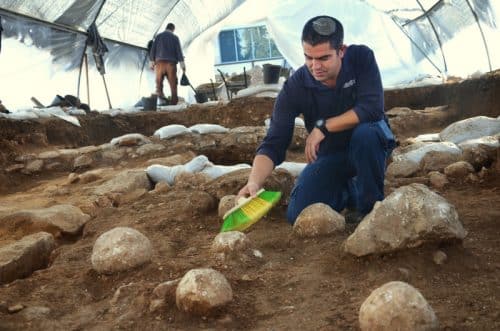Evidence of the breach of the "Third Wall" of Jerusalem at the end of the Second Temple period was discovered in the excavation of the Antiquities Authority in the center of the city, where the new campus of "Bezalel" will be built * Excavation managers: "The findings illustrate the intensity of the shelling"

Impressive and fascinating evidence of the battlefield and the valley of the "Third Wall" that surrounded Jerusalem at the end of the Second Temple period, were uncovered in the "Russian Field" in the center of the city. The find was discovered in an archaeological dig conducted by the Antiquities Authority last winter, at the site where the new campus of the Israeli National Academy of Art and Design - "Bezalel" - will be built. During the excavation, the archaeologists discovered the remains of a tower that protruded from the wall, and in front of the western facade of the tower were found many dozens of catapults and slingshots, which the Romans fired from machine guns at the Jewish wall guards, who were standing at the top of the tower.
According to Dr. Rina Avner and Kafir Arbiv, the managers of the excavation on behalf of the Antiquities Authority: "This is fascinating evidence of the intense bombardment of the Roman army, led by Titus, on their way to conquer the city and destroy the Second Temple. The bombardment was intended to attack the guards of the wall in order to cover and allow the Roman force to bring the ramming deer closer, and through them to score the wall." The historian and witness committee for the war, Yosef ben Matthew, gave many details about this wall. According to him, the wall was intended to protect the new quarter of the city, which began to develop outside its borders, and to the north of the two walls that already stood. The construction of the third wall was begun by King Agrippa I, but he stopped the construction so as not to arouse the wrath of the emperor Claudius, and to allay his doubts about his loyalty. The construction of the third wall was renewed about twenty years later, by the defenders of Jerusalem, as part of the fortification of the city and the preparation of the Jewish rebels for the great revolt against the Romans.
Ben Matatiyo described in detail the route of the wall, which begins at a tower called Hipficus, which is now identified with the citadel in the Tower of David. From there it continued north to the huge tower of Pasipinus, which protected the northwest corner of the wall. From there, the wall turned east and went down to the tomb of Helen the Queen, which is identified with the place known as the Tombs of the Kings.
From the beginning of the twentieth century until the current excavation, the debate regarding the identification of the third wall and the question of the borders of the city of Jerusalem on the eve of the Roman attack under the command of Titus has not been resolved. It seems that the new discovery in the Russian plot is proof of the existence of the wall's route in this area.
